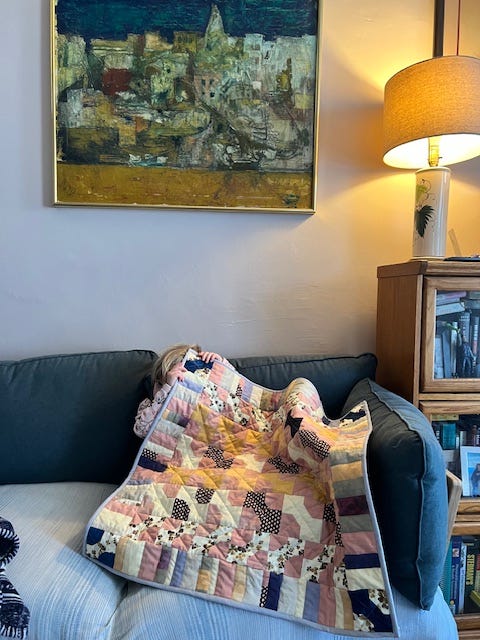Informing Heirlooms
I am fortunate to have multiple quilts from different family members. My great grandmother Clara was known for giving grandchildren and great (!) grandchildren quilts, mine being a sky-blue, Sunbonnet Sue. My child received a quilt of her own from my aunt on the same side. She also sleeps with a flannel baby quilt of mine with a giant easter bunny appliquéd over the top of worn transparent, tiny gingham green and white. They are precious heirlooms, my husband also having quilts made by his grandmother. As a family we both covet them and use them daily.

Quilts were acts of love and sustainability for my great grandma Clara, as was the tradition in the South. She would hold onto the scraps of clothing she had made, at one point her quilts like many others, utilizing feed sacks as well. She has since passed and I was fortunate enough to inherit both fabric and an unfinished flower garden quilt of hers I am determined to finish in my lifetime. Inheriting both, I am able to see how her quilts possess energies and mementos meant for many—she would also make clothes for family members, as did her daughter, my grandmother Annette. The same fabric that was lovingly used to make matching easter service dresses for me and my sister would also be set aside for cushions, quilts and the like.
The idea that we could use a quilt to tatters, and then stuff a new quilt with it as batting is poetic and ingenious. I love when things are resourceful, useful, and somehow also precious. I made my first quilt late last year for a friend. She had taken fabric and dyed it with plants, giving me the scraps. My sister had given me some batik fabric she had found second hand, which became the backing. I wanted to make something for Jess’s baby that her mom also had a hand in creating. It was such a learning process. It was meditative at times. It was also frustrating, and challenged my perfectionist tendencies. Working with scrap pieces allows me to feel hemmed in creatively, that is where I feel most cozy and safe to experiment. When I have the freedom to choose whatever pattern, new fabric and new color schemes I am too inundated with ideas to press onward. My vision for this quilt evolved as I made it, and that mentality has bled into my non-creative life. To not feel too precious or beholden to any idea I have about the way something in my life will unfold. To remember I am my harshest critic and sharing the things I make is an integral step.
This is why I landed on a quilt square inspired logo for my doula work, Jess running with the inspiration, using Many Hands Make a Quilt: Short Histories of Radical Quilting Zine (seemingly a must have if you are remotely interested in quilts). Quilt block patterns inherently relay messages, interacting with one another, the blanket interacting with the spaces they inhabit. They enshroud the person who owns it in warmth, protecting them with ideas touched by someone they have known and loved, the messages encoded. We used the crossroads and daffodil blocks, the crossroads pattern hailing from Jess’s home state of Ohio—the crossroads signifying a salient time in one's life when one has a choice to make and press onward, the daffodil representing self love. Below is some quilting by Jess, the fabric naturally dyed by her as well <3
My hope is that I can be a guide during what is often a mysterious and tumultuous time. I can fill in the blanks where society has deemed the information surrounding periods and menopause as shameful, secret, a sign of weakness, or non-existent. I don’t blame the people that came before us for the lack of support by ways of modeling and education. But what if we could experience peri/menopause confident we know what to expect, with community and healthful choices to buoy us when hormones are most erratic. We could manage the process instead of languish, and could then pass on that experience to the people that follow in our footsteps, friends and children alike. It is a precious and practical heirloom to build upon.






